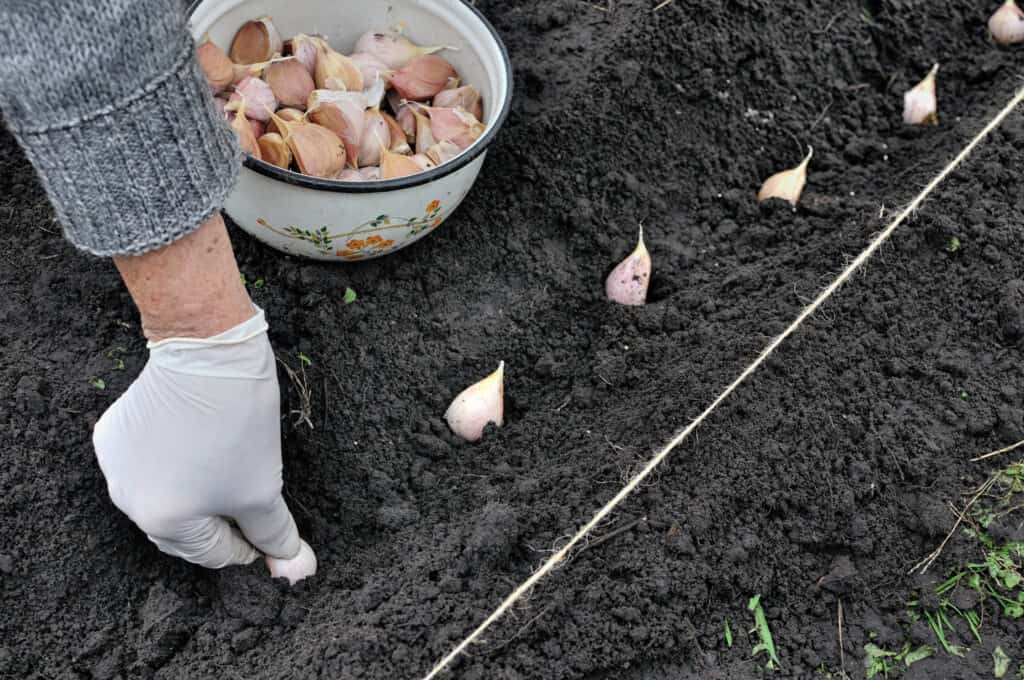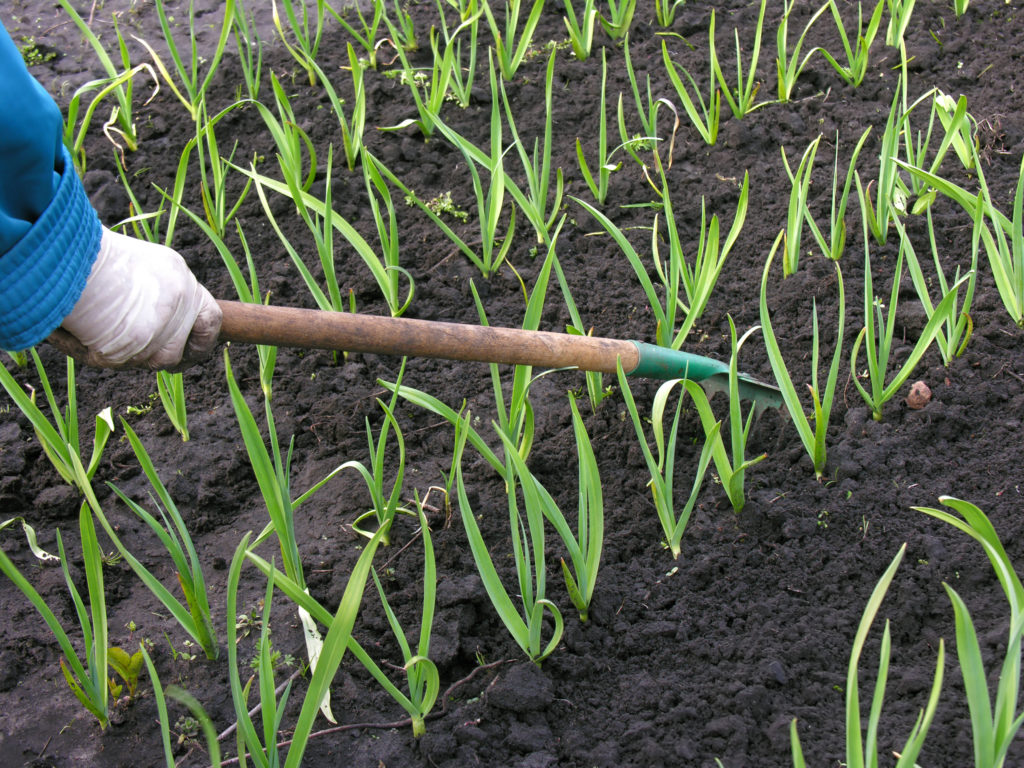Garlic is grown from cloves formed in bulbs. Cloves used to start new plants are called “seed cloves”. Seed clove size is important to yield.
The yield of a large clove is usually greater than a medium-sized clove, which, in turn, is usually greater than a small-size clove. The largest cloves commonly produce the largest bulbs.
Garlic grows best if days are short and cool at the start of growth and long and warm nearer harvest.
Plant garlic in the cool of autumn or early spring to gain the chilling needed for bulb formation. Bulb growth accelerates as the days grow warmer and longer in mid-to-late summer.
Plant garlic so that it receives cool temperatures during the early stages of growth when the leaves are developing. Later in the growing season, warm temperatures and long days are needed for the best bulb development.
Good Products for Growing Garlic at Amazon:
- Safer Brand Insect Killing Soap
- Monterey BT Caterpillar Killer
- Harris Diatomaceous Earth with Duster
- Bonide Sulfur Fungicide

Garlic is hardy and can withstand frost and light freezing. Elephant garlic can withstand temperatures lower than regular garlic.
Plant garlic cloves directly in the garden as soon as the soil can be worked in spring, or 4 to 6 weeks before the last frost. For an early start, sow cloves indoors 4 to 6 weeks before setting out. Set out seedlings 2 to 4 weeks before to 1 week after the last frost.
Plant cloves pointed side up, 1 inch deep. Space plants 2 to 6 inches apart.
Grow garlic in humus-rich, well-drained soil. Grow garlic in full sun. Keep weeds away from garlic early in the season as plants are developing.
Garlic bulbs mature in 90 to 100 days. The tips of plant tops can be snipped to use as garlic flavoring during the growing season. When leaves yellow and droop, harvest can beg
Grow garlic and other root crops in light-textured soil free of pebbles and stones. This will ensure roots do not become malformed.
Garlic matures in 90 to 100 after spring planting, about eight months after autumn planting.
Garlic planting details
- Sowing depth: 1 inch (2.5cm) pointed end up
- Space between plant after thinning: 2-6 inches (5-15cm)
- Days to sprout: 7-14
- Days to harvest: 90-100
- Storage period: 12-16 weeks
- Seeds for 100-row feet: 400 cloves pounds
- Yield per 100-row feet: 15 pounds
- Suggested Varieties: Giant Improved, Elephant, White or Mexican cultivars, Pink or Italian cultivars.
Garlic sowing and planting tips
- Grow garlic from seed cloves. Cloves should be chilled in storage at 41°F (5°C) for several months before planting
- Cloves are viable for about 1 year; papery, dehydrated cloves are not viable.
- In cold-winter regions, sow cloves in early spring up to 6 weeks before the last expected frost; also plant in autumn about 6 weeks before the soil freezes.
- In mild-winter regions, sow cloves very early in spring for harvest in late summer or sow in autumn for harvest the following mid-to late-summer.
- Sow cloves 2 inches (5 cm) deep; cloves for larger “elephant” garlic (see below) should be set 4 inches (10 cm) deep.
- Space cloves 4 to 8 inches (10-15 cm) apart in all directions; space elephant garlic 12 inches (30 cm) apart.
- Space rows of garlic 12 inches (30 cm) apart.
- Sow seed in loose, fertile soil. Adding aged compost to planting beds in advance of sowing will feed the soil and aid moisture retention.
- Seed cloves will germinate in 7 to 14 days at a temperature of 55°F (13°C) or thereabouts; germination will take longer in colder soil.
- The optimum soil temperature to grow garlic is 45°F to 85°F (7-29°C).
- Garlic prefers a soil pH range of 4.5 to 8.3.
- Grow garlic in full sun for best yield.
- Keep the soil evenly moist during growth—but do not saturate the soil; wet soil will cause bulbs to rot.
- Avoid fertilizers high in nitrogen; too much nitrogen will delay bulb formation.
- Garlic grown in potassium-deficient soil will not store well; garlic grown in phosphorus-deficient soil will have thick necks and mature more slowly.
- Keep planting beds free of weeds to avoid competition for moisture and nutrients.
- Avoid planting garlic where onions or leeks have grown recently.
- Fertilize with an organic fertilizer such as fish emulsion at half strength.
- Common garlic pest enemies include aphids, nematodes, and thrips. Protect young plants from pests and cold for two to three weeks after planting with spun poly-row covers.
Interplanting: Plant garlic with beets, celery, lettuce, spinach, and members of the cabbage family.
Container Growing Garlic: Choose a container 10 to 12 inches (25-30 cm) deep.

Garlic planting calendar
- Cold-winter regions: sow cloves in early spring up to 6 weeks before the last expected frost; also plant in autumn about 6 weeks before the soil freezes for harvest the next summer.
- Mild-winter regions: sow cloves in late winter or very early spring for harvest in late summer or sow in autumn for harvest the following mid-to late summer.
Garlic planting dates
(These dates are for the Northern Hemisphere)
| Average date of the last frost | Planting dates |
| Jan. 30 | Commonly fall planted |
| Feb. 8 | Commonly fall planted |
| Feb. 18 | Commonly fall planted |
| Feb. 28 | Commonly fall planted |
| Mar. 10 | Commonly fall planted |
| Mar. 20 | Feb. 1-Mar. 1 |
| Mar. 30 | Feb. 10-Mar. 10 |
| Apr. 10 | Mar. 10-Apr. 10 |
| Apr. 20 | Mar. 20-Apr. 20 |
| Apr. 30 | Apr. 1-30 |
| May 10 | Apr. 15-May 15 |
| May 20 | Apr. 20-May 20 |
| May 30 | May 1-30 |
| June 10 | May 15-June 1 |

Garlic types and classifications
There are three types of garlic to grow:
- Softneck garlic including silverskin and artichoke garlic: necks are soft and pliable at maturity; bulbs produce medium-sized cloves. These are the strongest-flavored garlic. They are less winter hardy than hard-neck but store better.
- Hardneck, stiff neck, or top-setting garlic, also called Spanish garlic: necks are stiff; stem curls in a loop at the top; mild-flavored and easy to peel.
- Elephant garlic: large, fist-sized bulbs; mild and easy to peel; not as hardy as other types.
Botanical Name: Allium sativum
Garlic is a member of the Alliaceae also called Lilliaceae family; other members of this family include onions and leeks.
Garlic articles at Harvest to Table:
How to Harvest and Store Garlic
Five Ways to Cook and Serve Garlic
Oyster Mushroom Sauteed in Garlic
Garden Planning Books at Amazon:
- Tomato Grower’s Answer Book
- Vegetable Garden Almanac & Planner
- Kitchen Garden Grower’s Guide Vegetable Encyclopedia
- Vegetable Garden Grower’s Guide















